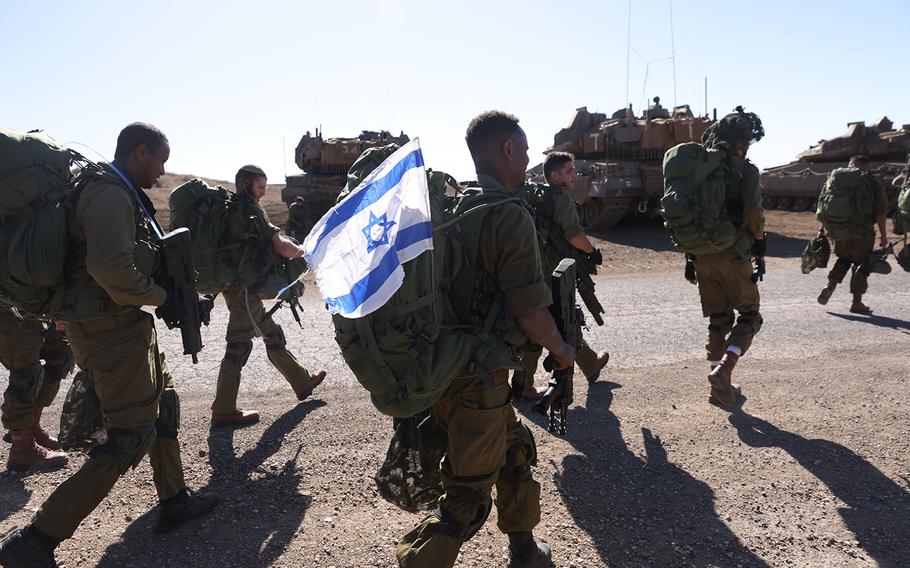Middle East
Israel fears war on the horizon against Hezbollah in the north
Bloomberg News November 10, 2023

Israeli soldiers walk during a drill in the annexed Golan Heights on Nov. 9, 2023, amid increasing cross-border tensions between Hezbollah and Israel as fighting continues in the south with Hamas militants in the Gaza Strip. (Jalaa Marey, AFP via Getty Images/TNS)
(Tribune News Service) — In Kibbutz Eilon, an Israeli cooperative a mile south of Lebanon, the avocado and banana farming families have been replaced by an infantry company specialized in mortars and anti-tank support. The boom of howitzers punctuates the soft air. There is a sense of impending conflict.
Ever since Hamas militants broke through the border fence in southern Israel on Oct. 7, killing and kidnapping their way into the neighboring communities, life on Israel’s northern border has taken a radical turn. Tens of thousands have been evacuated and the army has moved in with tanks, artillery and troops.
The fear is that Hezbollah, a Lebanon-based Islamist group, may be preparing to join the war — or breach the boundary with Israel in a fresh attack.
“We have to stay on this border to send a message of deterrence,” said Major Ariel, 30, the commander of the company in Eilon, who is on reserve duty. A physician and father of three young daughters, he adds, “My life is on hold. I don’t know how long I will be here but we can’t leave. October 7th was a wake-up call.”
Over the past five weeks, the world’s attention has been on Israel’s aerial and ground invasion of Gaza designed to uproot Hamas’s infrastructure and destroy the group’s military capability, with thousands of civilian casualties. But an equal — perhaps bigger — concern for Israel’s military and the country is Hezbollah, which has nearly 10 times the number of missiles as Hamas and a bigger, more professional fighting force. US carrier battle fleets are in the Mediterranean to warn Hezbollah and its sponsor, Iran, against joining in.
Both Hamas and Hezbollah are considered terrorist groups by the US.
Whether Hezbollah actually plans war with Israel is far from clear. Most analysts say Nasrallah doesn’t seem inclined. Cross-border fire between the two sides is a daily occurrence, yet has so far been relatively contained.
As Hezbollah leader Hassan Nasrallah said in a speech early this month, “What we have done since October 8 is unprecedented in terms of our fighting strategy. We have been engaged in a true battle.”
Israelis have been inhabiting a new reality, one in which they say if a militant group on its border preaches the country’s destruction, they can’t just wave it off as poisonous rhetoric. That’s what they did with Hamas.
“The most dramatic change since Oct. 7 is the fear of terrorist infiltration,” said Simona Menashe, the administrator of Kibbutz Kabri, a co-operative south of Eilon where other soldiers and equipment have been installed. “Hezbollah is more sophisticated than Hamas. They could take over the whole area. This is now in our heads.”
The parallels with the Gaza border are eerie. Kibbutzes — collective Israeli communities mainly focused on agriculture and minor manufacturing — are prevalent in both areas. They were established partly to serve as guard posts for the budding state and have been largely populated by secular Israelis who lean left and seek co-existence with Arabs. That didn’t stop them becoming targets for the Hamas massacre, which left an estimated 1,400 people dead.
Now these symbols of liberal Zionism have become again de facto security outposts, filled with military equipment and troops who see it as their mission to defend the country.
The experience of Major Ariel — his last name is withheld by the army for security reasons — in these weeks is telling.
“We have had to revise how we defend the line while keeping eye contact on the border and on the enemy and at the same time staying protected,” he said. He described how Hezbollah operatives have been targeting his platoon with anti tank missiles that are shot from tripods and with mortars, ranging from 60 to 155 millimeters.
“And for the first time, they’re using a big-headed rocket known as a Burkan, shot from pickup trucks. Hezbollah is always studying us. They use drones to track our movements.”
Ariel, who’s married to a fellow doctor he met in medical school, is supposed to start the next stage of his residency at a hospital outside Tel Aviv, but doesn’t know when that will happen.
“We all want to get back to our lives but this is our obligation to defend our country,” he said. “We are here indefinitely, and that is a huge burden on our economy.”
A nearby produce packing plant, Milopri, where avocados fly into different bins based on weight and quality, is now lacking skilled workers and can’t get to some fruit, which rots, said Uri Coves, as he carried his reserve-duty rifle on a tour of the facility.
This points to something many in the north are mulling quietly: After the war in Gaza has ended, will that trigger one in southern Lebanon? Israel previously fought Hezbollah in 2006, a conflict that ended with many Lebanese casualties. Since then, Hezbollah — backed by Iran — has greatly improved its military muscle.
“We have to take care of this,” said Dana Schlesinger, the head of a bank that handles finances for 15 local industries in the area. “The army can’t stay here forever to protect us this way.”
With assistance from Julius Domoney.
©2023 Bloomberg L.P.
Visit bloomberg.com.
Distributed by Tribune Content Agency, LLC.